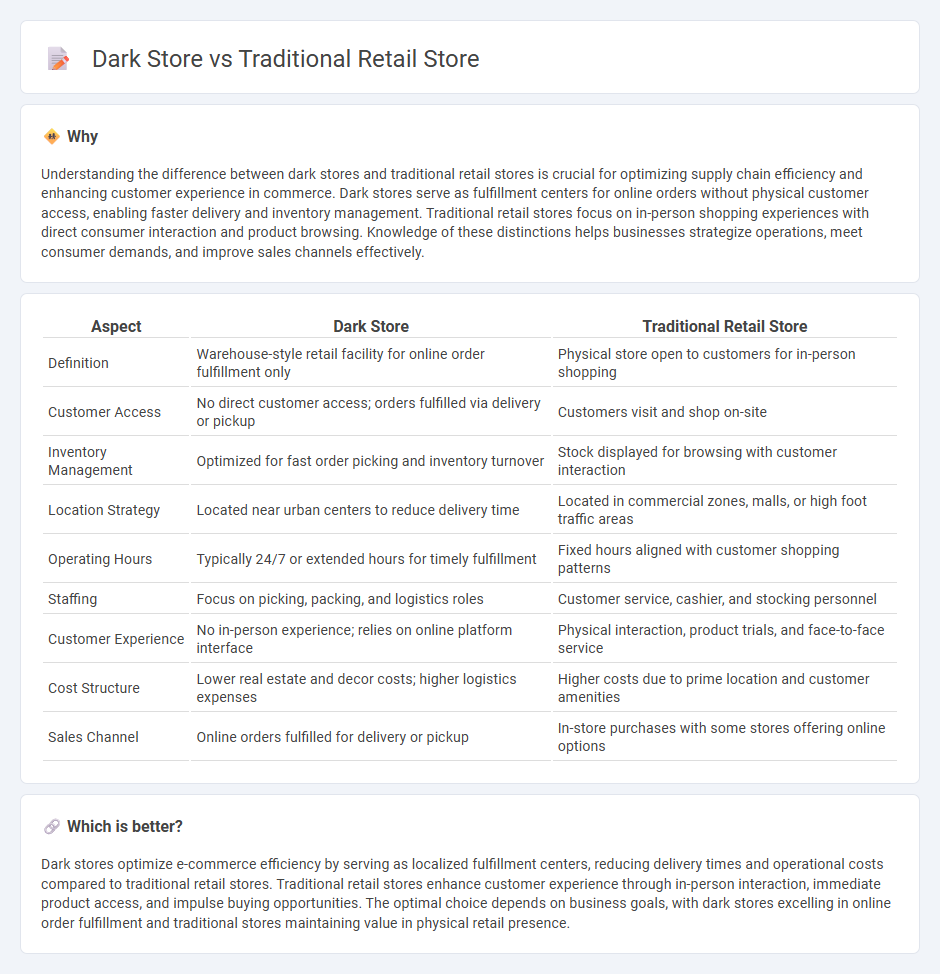
Dark stores optimize order fulfillment by serving exclusively as local distribution hubs without customer-facing retail spaces, enhancing speed and efficiency in e-commerce delivery. Traditional retail stores focus on in-person shopping experiences, offering immediate product access and personalized service within physical locations. Explore how these retail models shape the future of commerce and consumer convenience.
Why it is important
Understanding the difference between dark stores and traditional retail stores is crucial for optimizing supply chain efficiency and enhancing customer experience in commerce. Dark stores serve as fulfillment centers for online orders without physical customer access, enabling faster delivery and inventory management. Traditional retail stores focus on in-person shopping experiences with direct consumer interaction and product browsing. Knowledge of these distinctions helps businesses strategize operations, meet consumer demands, and improve sales channels effectively.
Comparison Table
| Aspect | Dark Store | Traditional Retail Store |
|---|---|---|
| Definition | Warehouse-style retail facility for online order fulfillment only | Physical store open to customers for in-person shopping |
| Customer Access | No direct customer access; orders fulfilled via delivery or pickup | Customers visit and shop on-site |
| Inventory Management | Optimized for fast order picking and inventory turnover | Stock displayed for browsing with customer interaction |
| Location Strategy | Located near urban centers to reduce delivery time | Located in commercial zones, malls, or high foot traffic areas |
| Operating Hours | Typically 24/7 or extended hours for timely fulfillment | Fixed hours aligned with customer shopping patterns |
| Staffing | Focus on picking, packing, and logistics roles | Customer service, cashier, and stocking personnel |
| Customer Experience | No in-person experience; relies on online platform interface | Physical interaction, product trials, and face-to-face service |
| Cost Structure | Lower real estate and decor costs; higher logistics expenses | Higher costs due to prime location and customer amenities |
| Sales Channel | Online orders fulfilled for delivery or pickup | In-store purchases with some stores offering online options |
Which is better?
Dark stores optimize e-commerce efficiency by serving as localized fulfillment centers, reducing delivery times and operational costs compared to traditional retail stores. Traditional retail stores enhance customer experience through in-person interaction, immediate product access, and impulse buying opportunities. The optimal choice depends on business goals, with dark stores excelling in online order fulfillment and traditional stores maintaining value in physical retail presence.
Connection
Dark stores serve as fulfillment centers for online orders, bridging the gap between e-commerce and traditional retail stores by enabling faster delivery and inventory management. Traditional retail stores benefit from dark stores by offloading online order processing, allowing them to focus on in-person customer experiences and sales. Both models integrate inventory data and logistics to streamline operations, improving overall commerce efficiency.
Key Terms
Physical storefront
Traditional retail stores feature a physical storefront designed to attract walk-in customers through window displays and personal shopper interactions, creating a tangible shopping experience. Dark stores operate without customer-facing spaces, focusing solely on fulfilling online orders efficiently within dedicated warehouses in urban areas. Explore the advantages and challenges of each model to understand their impact on modern retail strategies.
Click-and-collect
Traditional retail stores offer customers the advantage of browsing physical products before purchase, while dark stores focus solely on fulfilling online orders such as click-and-collect services efficiently without customer foot traffic. Dark stores leverage optimized layouts and technology to expedite order processing, minimizing wait times and improving inventory accuracy for pickup convenience. Explore the operational benefits and challenges of both models to determine the best fit for your retail strategy.
Fulfillment center
Traditional retail stores serve customers directly on-site, offering immediate product selection and purchase, while dark stores operate solely as fulfillment centers, optimizing inventory management and rapid order processing without customer foot traffic. Dark stores integrate advanced technologies like automated picking systems and real-time inventory tracking to enhance efficiency and support growing e-commerce demands. Explore how dark stores are revolutionizing fulfillment center strategies and transforming retail logistics.
Source and External Links
Grab and Go Autonomous Stores vs. Traditional Retail - AiFi - Traditional retail stores offer personalized customer service and immediate, tangible shopping experiences with human interaction, but face challenges like long lines, limited hours, and high labor costs.
Retail vs. E-commerce: What's the Difference? | Indeed.com - Traditional retail refers to physical stores where customers can interact directly with staff, try products before purchase, and avoid shipping costs, contributing to customer satisfaction and convenience.
The Fall of Traditional Retail Commerce | Nexcess - Traditional retail evolved from small "mom-and-pop" shops to department stores, shopping malls, and big-box stores, shaping in-person shopping culture before the rise of e-commerce.
 dowidth.com
dowidth.com